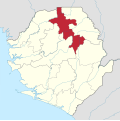Koinadugu District | |
|---|---|
 | |
 Location of Koinadugu District in Sierra Leone | |
| Coordinates: 9°30′N11°30′W / 9.500°N 11.500°W | |
| Country | Sierra Leone |
| Province | Northern Province |
| Capital | Kabala |
| Largest city | Kabala |
| Government | |
| • Type | District Council |
| • District Council Chairman | Alex Sorie Konteh (APC) |
| Area | |
• Total | 4,951 km2 (1,912 sq mi) |
| • Rank | 1st |
| Population (2021 census) [1] | |
• Total | 206,133 |
| • Density | 41.63/km2 (107.8/sq mi) |
| Time zone | UTC0 (Greenwich Mean Time) |
| HDI (2017) | 0.340 [2] low · 14th |
Koinadugu District is a district in the Northern Province of Sierra Leone. It is the largest districts in Sierra Leone in geographical area, and one of the least densely populated. Its capital and largest city is Kabala, which is also one of the main cities in Northern Sierra Leone. The district of Koinadugu has a population of 404,097, based on the 2015 Sierra Leone national census; [1] and a total area of 12,121 km2 (4,680 sq mi). Koinadugu District is subdivided into eleven chiefdoms. Pre-2017 Koinadugu has been divided into two districts. The district is less than half the area it used to be before 2017, now has a land area covering 4,951 km2 (1,912 sq mi). The district of Koinadugu borders Bombali on the west, Tonkolili District to the south-west, Kono District to the south, Falaba District to the east, and the Republic of Guinea to north east. Diamond mining is a major economic activity in the district, as well as agricultural production of rice, mango, cacao, and coconut.
Contents
- Government
- Demography
- Religion
- Members of Parliament
- Economy
- Administrative divisions
- Chiefdoms
- Villages
- See also
- References
- External links
The population of Koinadugu district is almost entirely made up of five main ethnic groups: the Kuranko, Mandingo, Fula, Limba, and Yalunka. These five ethnic groups are politically and culturally influential in Koinadugu District. Koinadugu District is overwhelmingly Muslim majority at over 90% and Islam dominates the religious and cultural practices in the district. There is also a small but significant minority Christian population in the district, and is mainly among the Limba people in the district.
